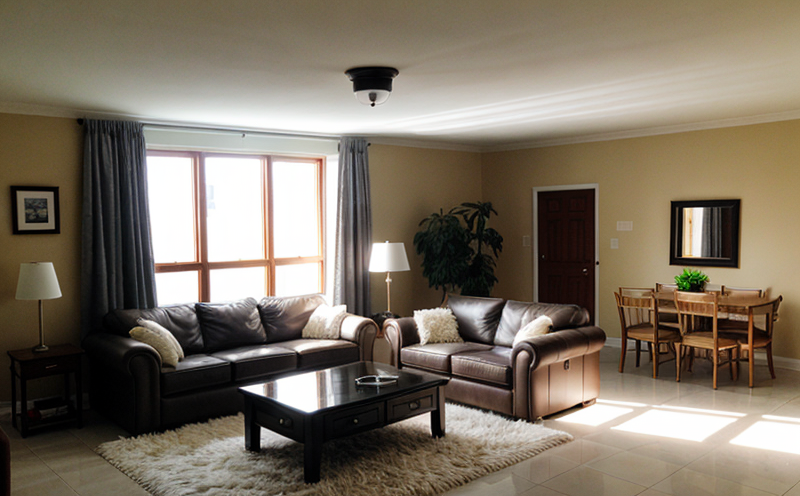ISO 50002 Indoor Lighting Energy Audit Testing
The International Organization for Standardization (ISO) has established a set of guidelines for energy management systems that help organizations to improve their energy efficiency. ISO 50002 specifically addresses the indoor lighting sector, providing detailed protocols on how to conduct an energy audit for indoor lighting installations.
In the context of Indoor Lighting Testing, this service is crucial for ensuring compliance with international standards and optimizing energy consumption. Conducting an energy audit according to ISO 50002 helps organizations identify areas where they can reduce their carbon footprint, lower operational costs, and enhance sustainability practices.
The audit process involves a thorough evaluation of the current lighting systems within a building or facility. It includes assessing the installed luminaires, their efficiency levels, the usage patterns, and any potential for improvement. The goal is to pinpoint inefficiencies that can be addressed through adjustments in system design, operational procedures, or equipment upgrades.
For quality managers, this service ensures that lighting installations meet not only regulatory requirements but also best practices recommended by industry leaders like ISO. Compliance officers benefit from having reliable data to support their compliance strategies. R&D engineers gain insights into cutting-edge technologies and methodologies for enhancing energy performance. Procurement teams can use the audit results to make informed decisions about purchasing more efficient products.
The service typically involves several key steps:
- Initial site visit to understand current lighting configurations
- Data collection on usage patterns, occupant behavior, etc.
- Analyzing data against ISO 50002 guidelines
- Identifying opportunities for improvement
- Presentation of findings and recommendations
The outcome is a comprehensive report that provides actionable insights into reducing energy consumption without compromising on functionality or aesthetic appeal.
| Applied Standards |
|---|
| ISO 50002:2014 – Energy management systems – Requirements with guidance for use |
Why It Matters
The importance of ISO 50002 Indoor Lighting Energy Audit Testing cannot be overstated in today’s world where sustainability and energy efficiency are top priorities. By adhering to these standards, organizations demonstrate their commitment to reducing greenhouse gas emissions and promoting environmental stewardship.
Energy audits help facilities understand the true cost of lighting operations beyond just electricity bills. They reveal hidden costs associated with wasted energy that could be minimized through better management practices. This knowledge empowers decision-makers to implement changes that yield long-term savings while contributing positively to global efforts against climate change.
Moreover, compliance with ISO 50002 can lead to certification or recognition from various bodies, enhancing an organization’s reputation and potentially opening up new markets or partnerships. It also ensures that all aspects of lighting installations are considered comprehensively—from initial design through installation and maintenance phases.
In summary, conducting an energy audit per ISO 50002 not only helps organizations save money but also contributes significantly to environmental protection efforts globally. The insights gained from such audits enable informed choices about future investments in sustainable technologies and practices within the lighting sector.
Applied Standards
| Standards Applied |
|---|
| ISO 50002:2014 – Energy management systems – Requirements with guidance for use |
| IEC TC 37 - Lighting equipment and systems |
| ASTM C1696-18 Standard Practice for Measuring Luminaire Efficiency |
| EN 16245 – Energy Performance of Buildings (EPBD) |
| IEC 62788 - Lighting control systems |
The application of these standards ensures that the testing process adheres to internationally recognized best practices, providing accurate and reliable results. These guidelines cover various aspects including luminaire efficiency measurement, lighting control system performance evaluation, as well as overall building energy performance assessment.
Quality and Reliability Assurance
- We use cutting-edge instrumentation calibrated to international standards.
- Data analysis is performed by experienced engineers with deep knowledge of ISO 50002 principles.
- All reports are reviewed multiple times for accuracy and completeness before final delivery.
- Audits follow a structured methodology that ensures consistent results across different sites or facilities.
- Continuous improvement processes ensure our methods remain up-to-date with evolving standards and technologies.
This commitment to quality assurance guarantees that clients receive precise, actionable information they can rely upon when making strategic decisions regarding their indoor lighting systems. Our team stays abreast of latest developments in the field to provide relevant advice on best practices and emerging trends.





